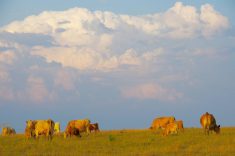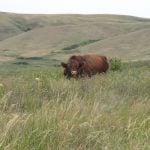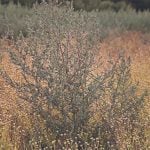In a year like this, feed testing is “prudent,” says Courtney O’Keefe, ruminant nutritionist with Blue Rock Animal Nutrition at Innisfail, Alta. “It’s going to help you make those decisions and balance that ration accordingly.”
O’Keefe takes us through a recent feed test (see example below) for mixed grass-legume hay, noting that nutritionists tend to focus on the top section of parameters (from moisture to iron).
Which column do I read?
“Make sure that you’re looking at the analysis and the numbers in the ‘dry’ column versus the ‘as fed.’ The ‘dry’ column is taking basically the moisture out and we’re just looking at the nutrients on their own,” says O’Keefe.
Read Also

Canadian Beef Check-Off Agency reports on investments and activities
The check-off agency’s work behind the scenes is what ensures cattle check-off dollars are invested wisely, accounted for transparently and deliver measurable value back to producers and importers.
Moisture and dry matter are the first areas O’Keefe looks at. This hay is as dry as it can be at zero per cent moisture and 100 per cent dry matter. “That’s important for determining dry matter content, which is important for determining how much feed you’re going to be providing those animals.”
Total digestible nutrients (TDN) refer to the feed’s energy value. For pregnant beef females, “we want to be targeting 55 per cent TDN in mid-gestation, 60 per cent TDN in late gestation and 65 per cent TDN in lactation,” says O’Keefe.
With 59.63 per cent TDN, this hay has the appropriate energy value to be fed without extra supplementation to cows through gestation. “Right after calving and at peak lactation is when we’d be concerned that the energy would be just a touch short.”

Crude protein encompasses protein and non-protein nitrogen. “For mid-gestation, we’re targeting seven per cent crude protein in the ration. In late gestation we’re targeting nine per cent and at lactation, we’re targeting 11 per cent,” she says. With a protein level of 13.12 per cent in this hay, it’s appropriate to feed through to lactation.
Neutral detergent fibre (NDF) provides the ration’s fill. This hay has 54 per cent NDF. Lower NDF levels are preferred, O’Keefe explains, and that level increases as plants mature. Straw also tends to have higher NDF values.
“When we’re starting to creep up over that 60 per cent for NDF is when we’d be concerned,” she says. “Those cattle would need some additional supplementation, just because they’d be running out of room with just the feed … to get enough of the nutrients they need out of it.”
Calcium and phosphorus should be looked at as a ratio, with the ideal range being 2:1 to 6:1. “We want to ensure we’re in between that range just to make sure that our calcium and phosphorus balance is appropriate so we don’t run into any other metabolic issues,” O’Keefe says.
With calcium at 1.27 per cent and phosphorus at 0.16 per cent in this hay, the ratio of calcium to phosphorus is 8:1, which requires additional phosphorus supplementation to balance the ratio.
Magnesium, potassium and calcium levels can be measured in what’s known as the tetany ratio. The tetany ratio is expressed as K/(Ca + Mg) in milliequivalents (mEq) per kilogram of dry matter. The ratio of potassium to the sum of calcium and magnesium should be below 2.2. to avoid winter tetany. To calculate, first convert percentages to mEq per kg.
- Ca (1.27 * 499)/100 = 6.34
- K (1.83 * 255.74)/100 = 4.68
- Mg (0.20 * 822.64)/100 = 1.65
Tetany Ratio = 4.68/(6.34 + 1.65) = 0.59. At 0.59, this hay’s tetany ratio is acceptable.
For sulphur, this hay is at a safe level of 0.15 per cent. “A concern more so with sulphur is when we get more on the high end, so that’s creeping up between 0.3 and 0.4 — that’s when we can see issues with sulphur toxicity.”
Sodium levels tend to be low in feed, says O’Keefe, and that’s the case here at 0.02 per cent. The trace minerals copper (4.32 mg/kg), manganese (56.75 mg/kg) and zinc (18.01 mg/kg) are also predictably low in this hay. “The majority of our feeds here in Western Canada are low in these trace minerals, so that’s why it’s important that we supplement them year-round,” she says.
Molybdenum, O’Keefe states, is usually not supplemented in a cow’s diet. “This is one that we just like to test because molybdenum is an antagonist to copper, so it is one that can tie up copper availability in the animal if it’s starting to creep up too high.”
Iron is another mineral that generally isn’t supplemented in beef cattle ration. “There’s typically more than enough between the feed and the water that’s available to them,” she says. The target for a gestation cow is around 50 mg/kg, and this sample fits the bill at 54.15 mg/kg.
Measured in percentage of crude protein, soluble crude protein refers to the nitrogen fractions most easily absorbed in the rumen. The soluble crude protein in this hay is 36.48 per cent of crude protein, falling near the average range of 30 to 35 per cent.
ADF-CP illustrates the amount of protein in the acid detergent fibre. This measurement is usually about one per cent in hay, so 0.85 per cent in this sample is a typical value. NDF-CP, on the other hand, refers to the amount of protein in the neutral detergent fibre.
UIP (undegradable intake protein), or bypass protein, refers to the amount of protein that is undegradable in the rumen and is instead digested in the small intestine. “For hay, the UIP is typically around 35 per cent of the crude protein. So on this sample, we’re on par for what we would expect to see.”
Acid detergent fibre is connected to forage digestibility; the lower the ADF value, the more digestible the forage. “For high-quality forage, like a legume hay, you might be running around that 20 to 35 per cent, and in a grass hay we’re probably looking at more between that 30 to 45 per cent,” says O’Keefe. This hay’s ADF of 37.58 per cent fits the expected value for a grass-legume mix.
Lignin represents the plant cell wall’s most indigestible material. “Your lignin value is going to go up as your plant matures,” she says, noting that this hay’s lignin level of 6.49 per cent denotes it was cut at the appropriate stage.
The starch level is 2.72 per cent in this hay. “Typically on hay we’ll see our starch levels be quite low in comparison, say, to a cereal grain or a silage crop such as barley or something like that.”

















